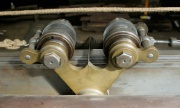Difference between revisions of "Kirkaldy Testing Museum"
| Line 37: | Line 37: | ||
[[Category: Town - London]] | [[Category: Town - London]] | ||
[[Category: Things to do - London]] | [[Category: Things to do - London]] | ||
[[Category: Testing | [[Category: Weighing and Testing Machinery]] | ||
Latest revision as of 13:03, 22 December 2019




at 99 Southwark Street, London, a short distance south of the Tate Modern Gallery.
The museum has been established to:
- To preserve David Kirkaldy's versatile testing machine in good working order and close to its original condition
- To retain as far as possible the Victorian character of the Works
- To explain to the public Kirkaldy's role in developing quality control by regular monthly opening and special open days
- To store and exhibit the Kirkaldy archive, and develop a library on the history of materials testing
- To build and maintain a representative collection of working testing machines.
It occupies the ground floor and basement of 99 Southwark Street in the Southwark area of London, just south of the Tate Modern gallery (which occupies the former Bankside Power Station.
This building was built in 1874 specifically to house "Kirkaldy's Testing and Experimenting Works". It was a place where experiments took place on materials to determine their strength. This was done primarily using David Kirkaldy's own design of testing machine, located in an area that was a hive of industry, and also close to the headquarters of industry, the engineering institutions, Government and Parliament.
See Also
Sources of Information
- Museum website [1]





